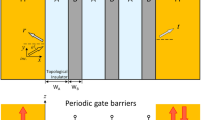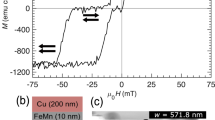Abstract
A spin valve is a layered structure of magnetic and non-magnetic (spacer) materials whose electrical resistance depends on the spin state of electrons passing through the device and so can be controlled by an external magnetic field. The discoveries of giant magnetoresistance1 and tunnelling magnetoresistance2 in metallic spin valves have revolutionized applications such as magnetic recording and memory, and launched the new field of spin electronics3—‘spintronics’. Intense research efforts are now devoted to extending these spin-dependent effects to semiconductor materials. But while there have been noteworthy advances in spin injection and detection using inorganic semiconductors4,5,6, spin-valve devices with semiconducting spacers have not yet been demonstrated. π-conjugated organic semiconductors may offer a promising alternative approach to semiconductor spintronics, by virtue of their relatively strong electron–phonon coupling7 and large spin coherence8. Here we report the injection, transport and detection of spin-polarized carriers using an organic semiconductor as the spacer layer in a spin-valve structure, yielding low-temperature giant magnetoresistance effects as large as 40 per cent.
This is a preview of subscription content, access via your institution
Access options
Subscribe to this journal
Receive 51 print issues and online access
$199.00 per year
only $3.90 per issue
Buy this article
- Purchase on Springer Link
- Instant access to full article PDF
Prices may be subject to local taxes which are calculated during checkout




Similar content being viewed by others
References
Baibich, M. N. et al. Giant magnetoresistance of (001)Fe/(001)Cr magnetic superlattices. Phys. Rev. Lett. 61, 2472–2475 (1988)
Moodera, J., Kinder, L., Wong, T. & Meservey, R. Magnetic tunnel junction. Phys. Rev. Lett. 74, 3273–3276 (1995)
Wolf, S. A. et al. Spintronics: a spin-based electronics vision for the future. Science 294, 1488–1495 (2001)
Kikkawa, J. M. & Awschalom, D. D. Lateral drag of spin coherence in gallium arsenide. Nature 397, 139–141 (1999)
Ohno, Y. et al. Electrical spin injection in a ferromagnetic semiconductor heterostructure. Nature 420, 790–792 (1999)
Hanbicki, A. T. et al. Efficient electrical spin injection from a magnetic metal/tunnel barrier contact into a semiconductor. Appl. Phys. Lett. 80, 1240–1242 (2002)
Xie, S. J., Ahn, K. H., Smith, D. L., Bishop, A. R. & Saxena, A. Ground-state properties of ferromagnetic metal/conjugated polymer interfaces. Phys. Rev. B 67, 125202 (2003)
Krinichnyi, V. I. 2-mm waveband electron paramagnetic resonance spectroscopy of conducting polymers. Synth. Met. 108, 173–222 (2000)
Friend, R. H. et al. Electroluminescence in conjugated polymers. Nature 397, 121–128 (1999)
Forrest, S., Burrows, P. & Thompson, M. The dawn of organic electronics. IEEE Spectr. 37, 29–34 (2000)
Voss, D. Cheap and cheerful circuits. Nature 407, 442–444 (2000)
Dediu, V., Murgia, M., Matacotta, F. C., Taliani, C. & Barbanera, S. Room temperature spin polarised injection in organic semiconductor. Solid State Commun. 122, 181–184 (2002)
Bowen, M. et al. Nearly total spin polarization in La2/3Sr1/3MnO3 from tunneling experiments. Appl. Phys. Lett. 82, 233–235 (2003)
Lee, S. T., Hou, X. Y., Mason, M. G. & Tang, C. W. Energy level alignment at AlQ/metal interfaces. Appl. Phys. Lett. 72, 1593–1595 (1998)
Arisi, E. et al. Organic light emitting diodes with spin polarized electrodes. J. Appl. Phys. 93, 7682–7683 (2003)
Dieny, B. et al. Giant magnetoresistance of magnetically soft sandwiches: dependence on temperature and on layer thicknesses. Phys. Rev. B 45, 806–813 (1992)
De Teresa, J. M. et al. Inverse tunnel magnetoresistance in Co/SrTiO3/La0.7Sr0.3MnO3: new ideas on spin-polarised tunnelling. Phys. Rev. Lett. 82, 4288–4291 (1999)
De Teresa, J. M. et al. Role of metal-oxide interface in determining the spin polarization of magnetic tunnel junctions. Science 286, 507–509 (1999)
Jullière, M. Tunneling between ferromagnetic films. Phys. Lett. A 54, 225–226 (1975)
Tsukagoshi, K., Alphenaar, B. W. & Ago, H. Coherent transport of electron spin in a ferromagnetically contacted carbon nanotube. Nature 401, 572–574 (1999)
Hayakawa, J. et al. The origin of bias-dependence in CoFe/SrTiO3/La0.7Sr0.3MnO3 magnetic tunnel junctions. J. Appl. Phys. 91, 8792–8794 (2002)
Acknowledgements
We thank X.G. Li at the University of Science and Technology of China for providing the LSMO films and C. Taliani, V. Dediu, V. Burtman and D. Smith for discussions. We also thank F. J. Wang, C. G. Yang, C. Z. Liu and M. DeLong for assistance with the measurements. This work was supported in part by the National Science Foundation, Petroleum Research Foundation, DARPA, and the Department of Energy.
Author information
Authors and Affiliations
Corresponding author
Ethics declarations
Competing interests
The authors declare that they have no competing financial interests.
Supplementary information
Supplementary Figure 1
GMR of LSMO/ Alq3/Co spin-valve devices of various spacer thicknesses, d, measured at 11 K. (PDF 75 kb)
Supplementary Figure 2
Room temperature external quantum efficiency of a control light-emitting ITO/Alq3/Co device with d = 160 nm. Both current-voltage, I(V), and electroluminescence intensity, EL(V), responses of this device are shown in the inset. (PDF 54 kb)
Supplementary Figure 3
The spin ½ resonance measured using the conductivity-detected magnetic resonance technique on a control ITO/Alq3/Co device. A relatively strong resonance at g ~ 2 shows that spin ½ carriers are indeed injected into the OSE spacer. (PDF 53 kb)
Supplementary Figure 4
The MR response of the bare Co electrode measured at bias voltage of 0.1 mV and 11 K. (PDF 57 kb)
Supplementary Figure 5
The MR response of the bare LSMO electrode measured at bias voltage of 5 mV and 11 K. (PDF 62 kb)
Supplementary Figure 6
The MR response of a control device ITO/Alq3/Co measured at bias voltage of 10 mV and 11 K. (PDF 58 kb)
Supplementary Figure 7
The I(V) of the ITO/parylene/ Co device measured at room temperature. (PDF 42 kb)
Supplementary Information and Figure Legends
This shows in more detail, the spin-valve giant magnetoresistance (GMR) measurements on devices with a variety of organic semiconductor (OSE) spacer thicknesses, in addition to those shown in Fig. 2a. Also shown are a number of magnetoresistance (MR) measurements on several devices that were fabricated specifically for the purpose of serving for control measurements in comparison with the real spin-valve devices. (DOC 31 kb)
Rights and permissions
About this article
Cite this article
Xiong, Z., Wu, D., Valy Vardeny, Z. et al. Giant magnetoresistance in organic spin-valves. Nature 427, 821–824 (2004). https://doi.org/10.1038/nature02325
Received:
Accepted:
Issue Date:
DOI: https://doi.org/10.1038/nature02325
This article is cited by
-
Strain-restricted transfer of ferromagnetic electrodes for constructing reproducibly superior-quality spintronic devices
Nature Communications (2024)
-
A framework for multiexcitonic logic
Nature Reviews Chemistry (2024)
-
Spin Route Flipping in FeCo/RR-P3HT/ NiFe Organic Spin-Valve Device
Electronic Materials Letters (2024)
-
Depth Resolved Magnetic Studies of Fe/57Fe/C60 Bilayer Structure Under X-Ray Standing Wave Condition
Journal of Superconductivity and Novel Magnetism (2024)
-
A spin–rotation mechanism of Einstein–de Haas effect based on a ferromagnetic disk
Frontiers of Physics (2024)
Comments
By submitting a comment you agree to abide by our Terms and Community Guidelines. If you find something abusive or that does not comply with our terms or guidelines please flag it as inappropriate.



